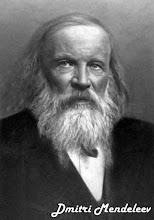
Periodic Table
The first periodic table was devised by Dmitri Mendeleev and published in 1869.
Mendeleev found he could arrange the 65 elements that were then known in a grid or table so that each element had:
1. A higher atomic weight than the one on its left.
2. Similar chemical properties to other elements in the same column.
He realized that the table in front of him lay at the very heart of chemistry. In his table he noted gaps - spaces where elements should be but none had yet been discovered.
In fact, just as Adams and Le Verrier could be said to have discovered the planet Neptune on paper, Mendeleev could be said to have discovered germanium (which he called eka-silicon because he observed a gap between silicon and tin), gallium (eka-aluminum) and scandium (eka-boron) on paper, for he predicted their existence and their properties before their actual discoveries.
Although Mendeleev had made a crucial breakthrough, he made little further progress because the Rutherford-Bohr model of the atom had not yet been formulated.
In 1913, Henry Moseley, who worked with Rutherford, showed it is atomic number (charge) and not (as Mendeleev had proposed) atomic weight that is most fundamental to the chemical properties of any element. Like Mendeleev, Moseley was able to predict correctly the existence of new elements based on his work.
And today the elements are still arranged in order of increasing atomic number (Z) as you go from left to right across the table. We call the horizontal rows periods and the vertical rows groups.
We also know an element's chemistry is determined by the way its electrons are arranged - its electron configuration.
The noble gases are found in group 18, on the far right of each period. The reluctance of the noble gases to undergo chemical reactions indicates that the atoms of these gases strongly prefer their own electron configurations - featuring a full outer shell of electrons - to any other.
In contrast to the noble gases, the elements with the highest reactivity are those with the greatest need to gain or lose electrons in order to achieve a full outer shell of electrons.
Elements sitting in the same group (e.g. the alkali metals in Group 1) all have the same number of outer electrons, leading to similar chemical properties.
Likewise the halogens in Group 17 also have similar properties to one another. When halogens react, they gain an electron to form negatively charged ions. Each ion has the same electron configuration as the noble gas in the same period. The ions are therefore more chemically stable than the elements from which they formed.
There is a progression from metals to non-metals across each period.
The block of elements in groups 3 - 12 contains the transition metals. These are similar to one another in many ways; they produce colored compounds, have variable valency and are often used as catalysts. The rare earth elements can be divided into lanthanides (elements 58 - 71) and actinides (elements 90 - 103). The naturally occurring rare earths are found on earth in only very small amounts. The actinides include most of the well-known elements that take part in or are produced by nuclear reactions. No element with atomic number higher than 92 occurs naturally. These elements are produced artificially in nuclear reactors or particle accelerators.

0 komentar:
Posting Komentar